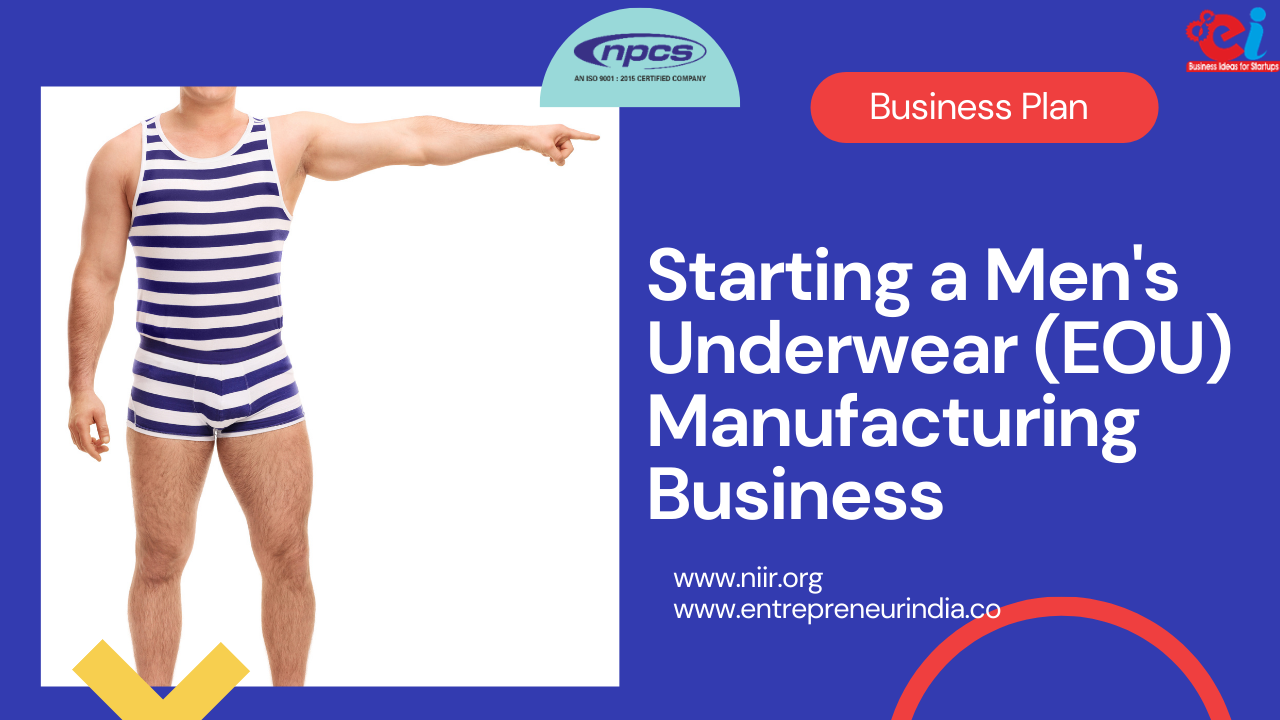
The men’s underwear manufacturing business is a booming sector within the broader garment and textile industry. With rising fashion awareness, improved income levels, and a growing focus on personal hygiene and comfort, men’s innerwear has evolved from being a basic necessity to a lifestyle product. No longer limited to standard white briefs, today’s consumers seek a variety of fits, fabrics, and designs—ranging from boxers and trunks to performance and designer underwear. This evolution presents a lucrative opportunity for manufacturers to establish strong, scalable brands catering to a loyal and recurring customer base.
Visit this Page for More Information: Start a Business in Readymade Garments Industry
Growing Demand and Market Opportunities
The innerwear market has traditionally been female-focused, but the men’s segment is rapidly catching up. The men’s underwear manufacturing business benefits from recurring purchases, low seasonality, and a broad consumer base across age groups and income levels. Increased awareness about grooming, social media influence, fitness culture, and online shopping platforms are driving demand for stylish, comfortable, and functional underwear for men. As disposable incomes rise in developing countries and premium brands emerge in developed markets, entrepreneurs have a ripe opportunity to build niche or mass-market labels.
Related Project Report: Manufacturing Industry of Mens Undergarment (EOU)
Understanding Product Categories
To succeed in the men’s underwear manufacturing business, it’s important to understand the different product segments. These include briefs, trunks, boxer shorts, boxer briefs, and jockstraps. Additionally, specialized types like thermal innerwear, moisture-wicking athletic underwear, and anti-microbial fabrics are becoming more popular. Each type appeals to different body types, usage purposes, and style preferences. Manufacturers can either focus on a single niche or offer a full range to cater to wider audiences.
Choosing the Right Fabrics
Fabric selection is a key component of quality and comfort. Cotton remains the most commonly used material in the men’s underwear manufacturing business, offering breathability and softness. However, blends like cotton-spandex or modal-cotton provide stretchability and improved fit. For athletic wear, polyester or nylon blends with moisture-wicking properties are preferred. Eco-friendly bamboo fabrics are also gaining attention for their sustainability and skin-friendly characteristics.
Read Similar Articles: Industry: Textile Industry
Setting Up Manufacturing Infrastructure
Setting up a men’s underwear manufacturing business requires planning and investment in specialized equipment. Basic infrastructure includes cutting tables, industrial sewing machines, overlock machines, elastic attachment systems, ironing units, and quality inspection setups. A small-to-medium scale unit can be started with 10–15 machines, while larger facilities may require automated cutters and computerized sewing setups. Proper layout planning ensures workflow efficiency and consistent production quality.
Watch Video: Men & Women Undergarment Manufacturing Business | Innerwear Garments Industry
Design and Pattern Development
Modern consumers expect well-designed and stylish underwear. Whether you’re targeting mass markets or premium segments, offering variety in color, prints, and fits is essential. Hiring skilled pattern makers and designers will help create appealing collections that cater to seasonal trends and customer preferences. In-house design capabilities give your men’s underwear manufacturing business a competitive edge, allowing for quick turnarounds and customization.
Related Feasibility Study Reports: Readymade Garments, Textile & Textile Auxiliaries, Hosiery, Spinning, Jeans and Under Garments
Branding and Packaging
Underwear is a brand-driven category. Successful innerwear brands invest heavily in visual appeal, packaging design, and brand storytelling. Sleek, resealable pouches or recyclable boxes can enhance customer perception. More importantly, branding should communicate comfort, masculinity, performance, or luxury—depending on the target audience. In the men’s underwear manufacturing business, a strong brand identity can build consumer trust and foster repeat sales.
Distribution and Sales Channels
Distribution plays a critical role in business success. Manufacturers can choose multiple channels: wholesale distribution, own-brand retail, e-commerce platforms, and B2B orders for private labels. Direct-to-consumer (D2C) brands are rising fast, using online storefronts and social media marketing to reach customers. Listing products on Amazon, Flipkart, Myntra, or other fashion platforms provides immediate visibility. Offline, tie-ups with departmental stores, boutiques, and supermarkets ensure retail penetration.
Watch other Informative Videos: Textile Industry
Private Label Manufacturing
An emerging trend in the men’s underwear manufacturing business is private label production. Here, manufacturers produce underwear for other brands or retailers under their label. This offers bulk orders and long-term contracts without the burden of brand marketing. With rising demand from online fashion startups, private labeling can be a steady source of revenue and growth.
Licensing and Legal Compliance
Depending on the country, your men’s underwear manufacturing business may need trade licenses, factory registration, GST or VAT registration, labor compliance, and product labeling clearances. For exports, ISO certification and compliance with international quality standards are often mandatory. Registering your brand and designs can also protect intellectual property in a competitive market.
Labor and Skill Requirements
The success of manufacturing depends on skilled tailors, cutters, supervisors, and quality control inspectors. While automation can reduce labor dependency, having trained staff ensures product consistency. Offering proper training and ensuring compliance with labor laws is essential for sustainable growth.
Sustainability and Eco-Conscious Production
Modern consumers are looking for sustainable fashion choices. The men’s underwear manufacturing business can adopt eco-friendly practices such as using organic fabrics, water-saving dyeing processes, plastic-free packaging, and ethical labor policies. These steps not only appeal to environmentally aware customers but also open doors to global retailers looking for green suppliers.
Profitability and Scaling Up
Men’s underwear is a high-repeat purchase item, and when manufactured at scale, it offers attractive margins. By optimizing fabric procurement, improving machine efficiency, and reducing wastage, manufacturers can maintain healthy profit margins. Branding, especially in the mid-premium segment, allows for better pricing. Once a business gains market traction, it can expand into related product lines like vests, undershirts, socks, or even performance wear.
Final Thoughts
The men’s underwear manufacturing business is a promising avenue for entrepreneurs looking to enter the fashion or textile sector. With high demand, recurring purchases, and brand-driven potential, this segment offers room for innovation and growth. Whether you’re launching your own label or working as a contract manufacturer, success lies in product quality, fabric innovation, strong branding, and smart distribution. As global tastes evolve and comfort becomes a central theme in fashion, the men’s underwear market is set to grow—and those who invest in quality and customer trust will lead the way.
Read our Books Here: Textile Spinning
See More Links:
- Start a Business in Asia
- Start a Business in Potential Countries for Doing Business
- Best Industry for Doing Business
- Business Ideas with Low, Medium & High Investment
- Looking for Most Demandable Business Ideas for Startups
- Start a Business in Africa
- Start a Business in India
- Start a Business in Middle East
- Related Videos
- Related Book
- Related Projects
- Related Market Research Reports





